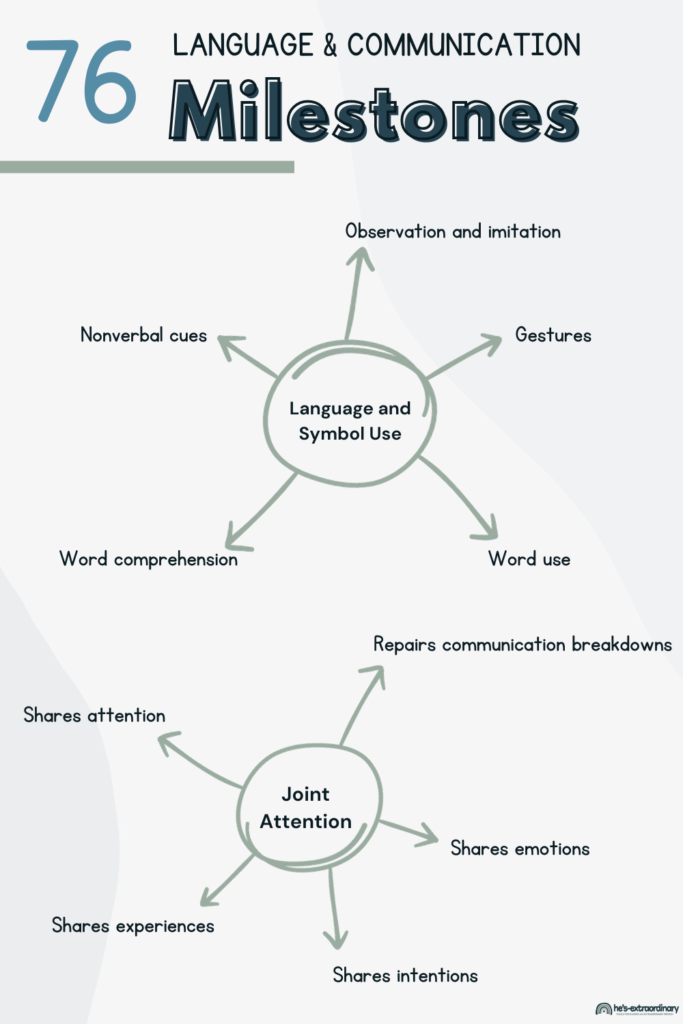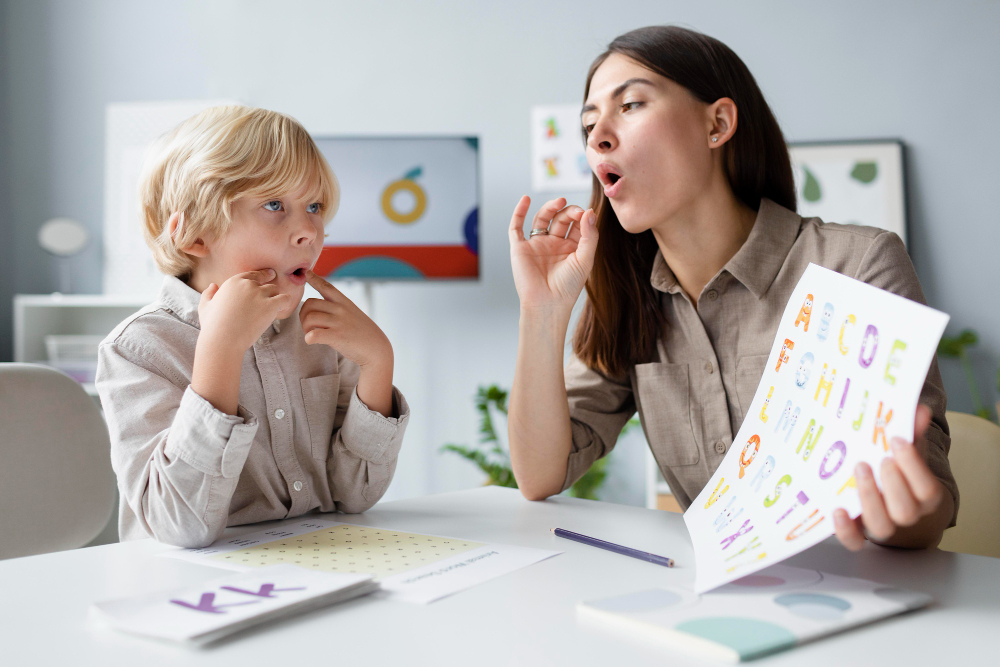Childhood Development: Language and Communication Milestones
What’s inside this article: A list of language and communication milestones in the order that they typically develop in children to use as a tool for identifying developmental gaps in autistic children. These milestones were obtained from The SCERTS Model: A Comprehensive Educational Approach For Children With Autism Spectrum Disorders.
Childhood development is extremely complex. It undoubtedly involves so many abilities that it would be impossible to place it all perfectly in a sequential list.
These lists are intended to show you some of the larger language and communication milestones in the order that they would typically develop for children.
This list does not include what age to expect each milestone to be met; it’s a tool for identifying possible developmental gaps in autistic children.
All children, especially those with autism, develop language and communication at their own pace. What’s most important is that they continue to progress and learn.
This post is part of a 7 part series on techniques for improving communication skills. Each part of the series contains this table of contents so you can easily navigate to the other parts of the series.
Table of Contents
- Learning to Listen & Oral Language Comprehension
- Developing Oral Language Expression
- Developing Social Language and Conversation Skills
- Milestones of Play & Targeting Skills Through Play
- Augmentative and Alternative Communication Tools
- Childhood Development: Language and Communication Milestones
- The Functions of Echolalia
All children are unique, and this includes their development. Consequently, language skills develop at different rates in different children.
However, if you have concerns about your child’s development, a developmental pediatrician can help determine specific areas of development that need nurturing.
In the meantime, this list will help you identify any developmental gaps that can be useful when working with your child’s team and creating goals.
The language and communication milestones in these lists
This model is often used by school professionals when creating individualized programming for children with ASD.
Language and Communication Milestones

Childhood development is commonly broken down into various domains. The language and communication
Joint attention development is more advanced than language/symbol use and is very social in nature. However, it is possible that skills will develop in each subdomain unevenly.
1. Language and Symbol Use
Learning by observation and imitation:
- Spontaneously imitates familiar actions or words immediately after a model. For example, a child mimicking a parent waving goodbye.
- Spontaneous imitation of unfamiliar actions or words immediately after a model. For example, a child repeating a new word after their parent.
- Spontaneous imitation of actions or words, adding in different behavior than the model.
- Spontaneously imitates a variety of behaviors and words later in a different context.
- Uses behaviors modeled by parents to guide social behavior.
- Uses internalized rules modeled by parent instruction to guide behavior. In other words, follows parents’ expectations without an immediate reminder of the “rules.”
- Collaborates and negotiates with peers in problem-solving independently.
Non-verbal cues
- Follows situational and gestural cues in familiar activities. Such as lining up when the bell rings or standing with everyone when the national anthem plays.
- Follows contact and distal point. For example, if you point to an object across the room, they can go retrieve that object.
- Follows instructions when provided with visual cues
- Responds to facial expressions and intonations
- Understands non-verbal cues for turn-taking and topic-change
- Understands non-verbal cues of emotional expression. In other words, they can guess your feelings based on your body language.
- Understands nonverbal cues and non-literal meanings of humor. Such as a person smiling and raising their eyebrows to show they’re joking.
- Understands various nonverbal cues and non-literal meanings of teasing, sarcasm, and deception. Such as winking to show you are teasing, eye-rolling to show sarcasm, or fidgeting when lying.
Use of gestures
- Uses a variety of conventional gestures. These include waving, clapping, nodding, shaking their head, pointing, etc.
- Coordinates both gestures and gaze (Points and looks at a toy simultaneously to show they want it)
- Uses appropriate facial expressions in context
- Uses appropriate gestures for the context
- Understands and uses body posture and proximity
- Uses appropriate volume and tone of voice for the context
Uses and understands words/language to express meanings
- Coordinates sound with gaze and gestures.
- Says 5-10 words or echolalic phrases as symbols
- Uses early relational words (this, that, here, no, all-gone, bye, more)
- Identifies various objects and people by name
- Uses a variety of advanced relational words (on, off, under, look, kiss, jump, dirty, mommy, etc)
- Uses a variety of relational meanings in word combinations (nice kitty, mommy shoe, baby sleep, water gone, more cookie)
- Understands and uses wh-words, describes things physically, numerically, kinship (brother, grandma, aunt, etc), casual words (fridge and refrigerator)
- Understands and uses pronouns, determiners, and plurals to reference things
- Uses a variety of verb phrases (daddy throw ball)
- Understands and uses a variety of sentence constructions.
- Uses connected sentences (oral and written). In other words, can speak and write using several consecutive sentences.
Understands words without contextual or gestural cues
- Responds to name when called
- Responds appropriately to a variety of familiar words and phrases. This includes phrases such as “Are you hungry?” or “Where is your blanket?”
- Understands a variety of names without contextual cues. So, if you say “John,” they will know you’re talking about your friend John even if he isn’t there or you haven’t described his appearance.
- Understands relational words without contextual cues
- Understands a variety of word combinations without contextual cues.
- Follows rules of conversation. This includes common social norms when initiating, turn-taking, shifting topics, or ending a conversation.
2. Joint Attention
For this sub-domain, the term “social partner” describes any person your child is interacting with. This includes parents, teachers, peers, therapists, etc.
Shares attention
- Monitors the attention of a social partner. So, they can identify if they appear interested or uninterested during conversation.
- Secures attention to oneself before expressing intentions. This may be done by gently tapping the other person’s arm, saying their name, etc.
- Understands nonverbal cues to shift the focus when conversing with a social partner.
- Modifies language based on what their social partner has seen or heard. For example, they wouldn’t tell their mom what was in their lunch box because they understand that their mom packed the lunch for them and already knows what’s inside.
- Shares internal thoughts or mental plans with a social partner. For example, tells a friend “After school, I’m going to the park”
Shares Emotions
- Understands and uses early emotion words (happy, sad, mad, scared)
- Describes the emotional states of others using early emotion words
- Understands and uses advanced emotion words (frustrated, nervous, excited, proud, boredom)
- Describes the emotional states of others using advanced emotion words
- Understands and uses graded emotions (ex on a graded scale “anger” would range from irritated or annoyed, to furious or enraged.
- Understands nonverbal cues of emotion expression (furrowed brow, crossed arms, smiling, etc)
- Describes plausible factors for emotions of self or others. For example, they may say “I’m sad because I lost my toy car”
Shares Intentions for Various Purposes
- Requests desired objects and activities
- Protests/refuses undesired objects and activities
- Requests help when needed
- Requests a break when needed
- Shares intentions for social interaction – greets, calls, requests permission, shares secrets, requests comfort, expresses empathy
- Comments on immediate, past, and imagined events
- Provides requested information about immediate and past events, when asked
- Expresses feelings and opinions about a variety of topics
- Anticipates and plans outcomes
Shares Experiences in Reciprocal Interaction
- Shows reciprocity in speaker and listener roles sharing experiences. In other words, they can both share information and focus on what their social partner shares.
- Initiates a variety of conversational topics
- Initiates and maintains conversations that relate to their social partners’ interests
- Maintains social interactions by requesting or providing relevant information. For example, if someone says they read a book over the weekend, your child can maintain the interaction by asking questions like “what book did you read?” or “did you like it?”
- Provides relevant information based on social partners’ knowledge of a topic
- Gauges length and content of conversational turn based on partners’. In other words, they can judge how much information to share and how long to talk based on how much information was shared by the social partner.
- Prefers spending time engaging with others as opposed to being alone. Has friendships with partners who share similar interests as they do.
Persists and Repairs Communication Breakdowns
- Uses appropriate rate of communication for the context
- Repeats and modifies communication to repair breakdowns. This means if their social partner didn’t understand what they meant they will reword in order to clarify their message.
- Recognizes breakdowns in communication and requests clarification if needed. This means if they don’t understand what another person said they will ask for clarification.
- Modifies language and behavior based on partner’s change in agenda
- Modifies language and behavior based on partner’s emotional reaction
- Expresses feelings of success and confidence during social interactions.
In order to help your child develop language and communication
If you try to teach skills that are too advanced for your child the result will be little or no progress, which can be discouraging.
Each of these language and communication milestones listed under each subheading builds upon the last.
However, your child’s development may be uneven across categories. These milestones are a tool to help you get an idea of your child’s development and to plan strategies to help improve communication skills.
Were there any specific skills in the list that are just emerging for your child? Make note and use these as a starting point for teaching new skills.

